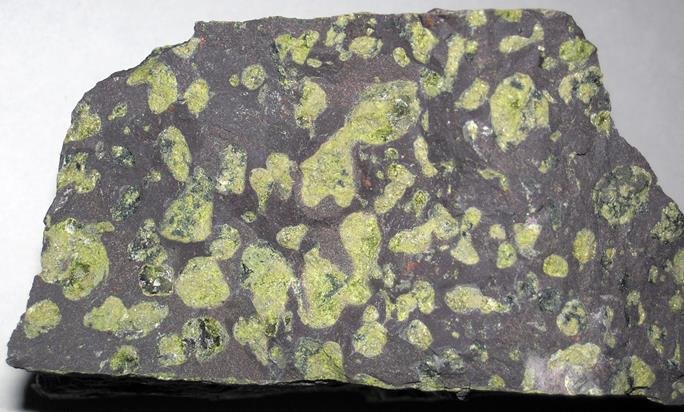Amygdales are small, round, or almond-shaped vesicles partly or fully filled with secondary minerals mostly common in volcanic or extrusive rocks.
Vesicles are gas bubbles trapped within igneous rocks as lava or magma solidifies. They form when dissolved gases exsolve as magma rises towards the Earth’s surface.
On the other hand, secondary minerals don’t originate directly from magma or lavas and form later. Instead, fluids, including hydrothermal fluids, percolate into the vesicles.
Some secondary minerals in amygdales include calcite, quartz, epidote, prehnite, chlorites, zeolites, chalcedony, or agate.
The word amygdale comes from the Latin word amygdala. Amygdala means almonds since these mineral-filled vesicles resemble almonds.
Rocks or lavas with amygdales are said to be amygdaloidal. Common examples are basalt, basaltic andesite, and andesite. However, they can occur in other rocks, too, including rhyolite.
Lastly, some amygdales common on the lower margins of basaltic flows are pipe-shaped, not nearly spherical or almond-shaped. Such are often known as pipe-stem amygdales.

How do amygdales form?
Vesicles form when solidifying magma traps some escaping gases during a volcanic eruption. These gases, usually carbon dioxide, water vapor, sulfur, and others, exsolve from rising magma as pressure drops.
Later, mineral-bearing, water-rich fluid – underground water and post-magmatic hydrothermal fluids – will percolate into the vesicles. These fluids will then deposit or precipitate various secondary minerals, forming amygdales.
Sometimes, the secondary minerals may form druses. Druses are well-developed small mineral crystals projecting from the surface of the vesicle.
For instance, the amygdale of agate commonly has druse amethyst crystal.
Lastly, the erupting lava must have dissolved gases for amygdaloidal rocks to form. Otherwise, no vesicles will form.
Examples of amygdaloidal rocks
Amygdales are common in extrusive or volcanic rocks. However, they can occur in subvolcanic or shallow plutonic rocks.
Subvolcanic rock, or hypabyssal rock, forms at shallow depths less than 2 km (1.2 mi) from the Earth’s surface.
Most of the amygdaloidal rocks form from basic or mafic magmas. However, they can occur in intermediate rocks like andesite or even felsic or acidic ones like rhyolite.
Mafic rocks are low in silica, high in dark-colored minerals rich in iron and magnesium, and low in felsic minerals or light-colored elements.
In contrast, felsic rocks are high in silica and relatively high in light elements like sodium, potassium, aluminum, oxygen, and silicon or felsic minerals but low in mafic minerals.
Intermediate lie in between mafic and felsic. They lie between silica, mafic, and felsic in chemical and mineral composition.
Examples of amygdaloidal rocks include basalt, basalt andesite, andesite, and rhyolite.
Let us look at basalt and andesite.
1. Amygdaloidal basalt
Basalts are dark-gray to black volcanic or extrusive rocks with a fine-grained texture. However, they often show other textures, including amygdaloidal.
These rocks have basic rocks with 45-52 wt. % silica. Also, they are relatively high in mafic minerals and low in felsic ones.
They have mostly calcic plagioclase and augite, a clinopyroxene. However, they can also have minor amounts of olivine, alkali feldspar, quartz, and, less often, biotite or hornblende.
Amygdaloidal basalt can occur in pahoehoe and aa lava flows. Also, they may occur in thick flood basalt or even submarine pillow lavas.
2. Amygdaloidal andesite
Amygdaloidal andesite is an andesitic rock whose vesicles are filled with secondary minerals.
Like other amygdaloidal rocks, they form an eruption of gas-filled magma or lavas. These lavas will form vesicles when they solidify.
Later, water-rich fluids deposit secondary minerals in vesicles formed as magma solidified into rocks.
Andesite is a light to dark-gray fine-grained, intermediate extrusive, or volcanic rock. It has 57-63 wt.% silica, <7 wt.% alkalis, and is moderate calcium and iron.
Its mineral composition is predominantly sodium-rich plagioclase and pyroxene. It also has less hornblende and may have minor quartz and alkali feldspar.
Biotite and muscovite are uncommon but can exist, while accessory minerals include garnet, magnetite, apatite, zircon, and ilmenite.
Lastly, besides amygdaloidal texture, this rock can have porphyritic, trachytic, vesicular, and poikilitic textures.
Amygdale minerals
Most of the minerals in amygdaloidal precipitate at low temperatures. These include
- Zeolite group: Natrolite, chabazite, analcime, stilbite, heulandite and mordenite
- Carbonates: Calcite, dolomite, aragonite
- Silica polymorphs: Chalcedony, including agate, opal quartz, and amethyst.
Other common ones are chlorite, prehnite, datolite, saponite, pectolite, pumpellyite, etc.
However, vesicles can also have igneous minerals or glass if they form at high temperatures.
Significance
This texture signifies that bubbles were completely trapped by magma as they solidified. Such magma was rich in dissolved gases.
Secondly, some amygdaloidal rocks contain valuable minerals. For instance, the Lake Superior district native copper deposits occur in sandstone and conglomerate interstices and fill amygdaloidal lavas.
Don’t confuse amygdales with phenocrysts.
When abundant, it is easy to confuse amygdales with phenocrysts. However, phenocrysts formed large mineral grains or crystals in a finer-grained matrix or groundmass. They originate from magma, i.e., are primary minerals.

Very interesting and clear definition Enjoyed the read..
If I have a specimen that I can’t identify could I send a picture to your site seeking information?
Thank you for your compliment. We will be excited to receive your image of the suspected amygdaloidal rock you are unable to identify. We will share it on our website and ask our readers to help us identify it. Drop us an emial